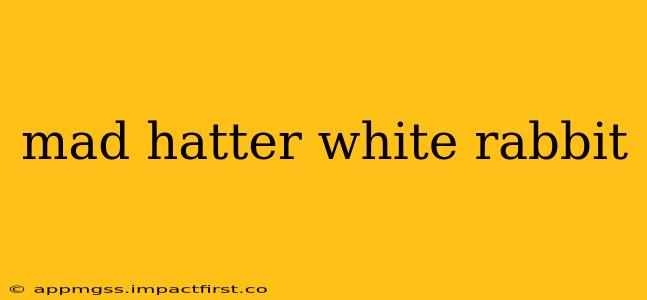Lewis Carroll's Alice's Adventures in Wonderland has captivated readers for generations, and two of its most memorable characters are undoubtedly the Mad Hatter and the White Rabbit. These seemingly eccentric figures represent more than just whimsical absurdity; they embody deeper themes of societal norms, time's relentless march, and the absurdity of the adult world as seen through a child's eyes. This exploration delves into their individual characteristics, their intertwined relationship, and their enduring legacy in popular culture.
Who is the Mad Hatter?
The Mad Hatter, a hatter by trade, is perhaps the most instantly recognizable character. His madness isn't a simple affliction; it's a chaotic blend of nonsensical pronouncements, illogical behavior, and a peculiar obsession with tea parties. He's a product of his environment – a world where logic and reason have dissolved into a surreal landscape. His erratic behavior serves as a commentary on the stifling constraints of Victorian society and the consequences of conforming to unreasonable expectations. He's rebellious, unpredictable, and ultimately, fascinating in his complete disregard for social norms.
What about the White Rabbit?
The White Rabbit, in contrast to the Mad Hatter's chaotic energy, embodies the relentless pressure of time and the anxieties of responsibility. Constantly late, perpetually fretting, and obsessed with his pocket watch, he represents the adult world's anxieties and the relentless pursuit of efficiency. He's a symbol of societal expectations and the stifling nature of adhering strictly to schedules and rules. Unlike the Mad Hatter's playful chaos, the White Rabbit's frantic energy reflects the stressful realities of Victorian life, where punctuality and adherence to social decorum were paramount.
What is the relationship between the Mad Hatter and the White Rabbit?
While seemingly disparate, the Mad Hatter and the White Rabbit share a fascinating dynamic. Their contrasting personalities highlight the duality of human experience: the playful rebellion against societal constraints (Mad Hatter) versus the anxious adherence to them (White Rabbit). Their interactions within the narrative often serve as catalysts for Alice's journey through Wonderland's nonsensical landscape. Their contrasting approaches to life underscore the multiple ways individuals respond to the pressures and absurdities of the world.
What are the Mad Hatter's most famous quotes?
The Mad Hatter's dialogue is filled with memorable pronouncements, reflecting his whimsical and nonsensical nature. Some of his most famous quotes include:
- "Have I gone mad?" This is perhaps the Mad Hatter's most poignant line, encapsulating his acceptance of his own unconventional behavior.
- "But I don't want to go among mad people," Alice remarked. "Oh, you can't help that," said the Cat: "we're all mad here."" This quote is frequently cited and speaks to the all-encompassing nature of Wonderland’s absurdity.
- "Why is a raven like a writing desk?" This famous riddle, left unanswered in the book, has become synonymous with the Mad Hatter’s enigmatic nature and the illogical nature of Wonderland itself.
Why are the Mad Hatter and White Rabbit so popular?
The enduring popularity of the Mad Hatter and the White Rabbit stems from their relatable qualities, even within their fantastical context. They represent aspects of the human experience that resonate across time and cultures: the desire for freedom from societal constraints (Mad Hatter), the pressures of responsibility and time (White Rabbit), and the inherent absurdity of life itself. Their iconic imagery – the Mad Hatter’s top hat and teacup, the White Rabbit’s waistcoat and pocket watch – contribute to their enduring recognition and cultural relevance. They've inspired countless adaptations, interpretations, and merchandise, solidifying their place in popular culture.
What are some other interpretations of the Mad Hatter and the White Rabbit?
Many literary critics have offered varied interpretations of the Mad Hatter and the White Rabbit. Some see them as representing the conflicting aspects of human nature: creativity versus conformity, chaos versus order. Others view them as symbolic of the different stages of life, with the Mad Hatter representing youthful rebellion and the White Rabbit representing the responsibilities of adulthood. The characters' open-ended nature allows for multiple interpretations, enriching their enduring appeal.
This exploration of the Mad Hatter and the White Rabbit offers a deeper understanding of their significance within Alice's Adventures in Wonderland. Beyond their whimsical charm, they provide insightful commentary on societal pressures, the nature of time, and the enduring fascination with the absurdity of life itself. Their enduring popularity serves as a testament to Carroll's masterful storytelling and the timeless appeal of his iconic characters.
